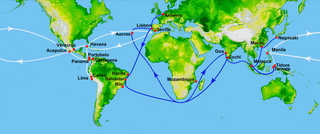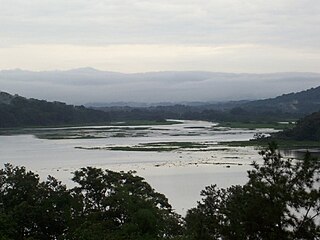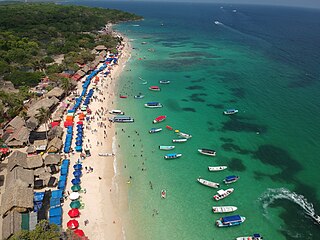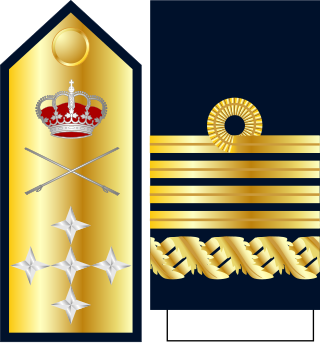
Nuestra Señora de Atocha was a Spanish treasure galleon and the most widely known vessel of a fleet of ships that sank in a hurricane off the Florida Keys in 1622. At the time of her sinking, Nuestra Señora de Atocha was heavily laden with copper, silver, gold, tobacco, gems, and indigo from Spanish ports at Cartagena and Porto Bello in New Granada and Havana, bound for Spain. The Nuestra Señora de Atocha was named for the Basilica of Nuestra Señora de Atocha in Madrid, Spain. It was a heavily armed Spanish galleon that served as the almirante for the Spanish fleet. It would trail behind the other ships in the flotilla to prevent an attack from the rear.

The Spanish treasure fleet, or West Indies Fleet, was a convoy system of sea routes organized by the Spanish Empire from 1566 to 1790, which linked Spain with its territories in the Americas across the Atlantic. The convoys were general purpose cargo fleets used for transporting a wide variety of items, including agricultural goods, lumber, various metal resources such as silver and gold, gems, pearls, spices, sugar, tobacco, silk, and other exotic goods from the overseas territories of the Spanish Empire to the Spanish mainland. Spanish goods such as oil, wine, textiles, books and tools were transported in the opposite direction.

Admiral Blas de Lezo y Olavarrieta was a Spanish navy officer best remembered for the Battle of Cartagena de Indias (1741) in the Viceroyalty of New Granada, where Spanish imperial forces under his command decisively defeated a large British invasion fleet under Admiral Edward Vernon.

Admiral Sir Charles Wager was a Royal Navy officer and politician who served as First Lord of the Admiralty from 1733 to 1742. Despite heroic active service and steadfast administration and diplomatic service, Wager can be criticized for his failure to deal with an acute manning problem.

The Battle of Cape Santa Maria was a naval engagement that took place off the southern Portuguese coast, in which a British squadron under the command of Commodore Graham Moore attacked and defeated a Spanish squadron commanded by Brigadier Don José de Bustamante y Guerra.

HMS Expedition was a 70-gun third-rate ship of the line built at Portsmouth Dockyard in 1677/79. She was in active commission during the War of the English Succession participating in the battles of Beachy Head and Barfleur. She was rebuilt in 1699. Again, for the War of Spanish Succession she was in commission for the operation at Cadiz then returned to England where she sat for two years. She was in the Mediterranean for the Battle of Marbella in 1705. She then went to the West Indies and fought in Wager's action off Cartagena in 1708. She was rebuilt in 1709-14 to the 1706 Establishment. She spent her time split between the Baltic and as guard ship at Portsmouth before being broken at Portsmouth in 1736. She was rebuilt in 1736/40 at Deptford Dockyard.

HMS Portland was a 50-gun fourth rate ship of the line of the Royal Navy, launched at Woolwich Dockyard on 28 March 1693.
A number of ships of the Spanish Navy have borne the name San José in honour of Saint Joseph

The Battle of Cádiz (1656) was an operation in the Anglo–Spanish War (1654–1660) in which an English fleet destroyed or captured the ships of a Spanish treasure fleet off Cádiz.

The Battle of Santa Cruz de Tenerife was a military operation in the Anglo-Spanish War (1654–60) which took place on 20 April 1657. An English fleet under Admiral Robert Blake penetrated the heavily defended harbour at Santa Cruz de Tenerife in the Spanish Canary Islands and attacked their treasure fleet. The treasure had already been landed and was safe but the English engaged the harbour forts and the Spanish ships, many of which were scuttled and the remainder burnt. Having achieved his aim, Blake withdrew without losing any ships.

San Ildefonso was a ship of the Spanish Navy, built at Cartagena, Spain to a design by José Romero Fernández de Landa and launched in 1785. She was designed to be lighter than traditional Spanish vessels which had had difficulty matching the speed of ships of the Royal Navy. Though completed as a 74-gun ship, and always rated as such, San Ildefonso actually carried 80 cannons and obuses (howitzers) by the time of Trafalgar. She saw service against French and British vessels in the late 18th century, sailed twice to the Americas and was trapped in Cadiz by the British blockade. San Ildefonso was captured by the British third-rate HMS Defence at the Battle of Trafalgar and successfully weathered the storm afterwards to be taken into Royal Navy service as HMS Ildefonso.

Francisco Díaz Pimienta (1594–1652) was a Spanish naval officer who became Captain general of the Ocean Fleet.
The capture of the galleon San Joaquin or the battle of Cartagena was a naval engagement that took place off the coast near Cartagena. It involved five British ships of the line against the Spanish galleon San Joaquin and a smaller ship. After an action lasting barely an hour the Spanish ship surrendered. The galleon had fought in the previous encounter during Wager's Action nearly three years earlier but had just barely escaped capture.
The following is a timeline of the history of the city of Cartagena de Indias, Colombia.

Encarnación, was an armed Spanish merchant ship of the Nao class, which was built in Veracruz, Viceroyalty of New Spain, likely sometime in the mid-1600s. The ship sank in a storm in 1681 at the mouth of the Chagres River and was discovered by archaeologists from the Texas State University in 2011.

San José was a 64-gun, three-masted galleon of the Spanish Armada de la Guardia de la Carrera de las Indias. It was launched in 1698 and sank in battle off Barú Island, just south of Cartagena, Colombia, in 1708, while laden with gold, silver and emeralds worth about US$17 billion as of 2023.

The Isla Barú or Isla de Barú is a former peninsula south of Cartagena, Colombia. It was cut off from the mainland by the Canal del Dique, but is still connected by bridge. It projects out southwest from the southern end of Cartagena towards the Islas del Rosario. It is approximately 25 km long and in places is less than 1 km wide. Approximately 20,000 people live on the island.

Purísima Concepción, was a Spanish first-rate ship of the line of the Kingdom of Spain's Armada Real in service between 1779 and 1810.

Captain general of the Navy is the highest naval officer rank of the Spanish Navy, rated OF-10 with the NATO ranking system. The routine honorary appointments formally ceased in 1999. The rank of captain general of the Navy is equivalent to an admiral of the fleet in many nations, a captain general of the Spanish Army or an Captain general of the Air Force in the Spanish Air and Space Force.
















